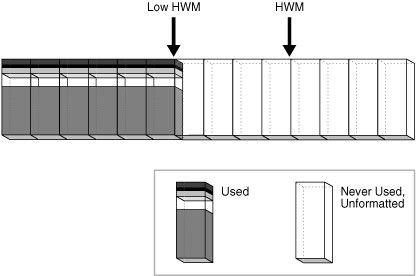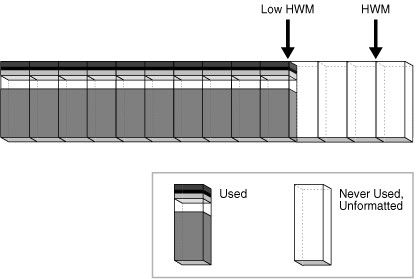高水位线(HWM)
一、什么是水线(High Water Mark)?
所有的oracle段(segments,在此,为了理解方便,建议把segment作为表的一个同义词) 都有一个在段内容纳数据的上限,我们把这个上限称为"high water mark"或HWM。这个HWM是一个标记,用来说明已经有多少没有使用的数据块分配给这个segment。HWM通常增长的幅度为一次5个数据块,原则上HWM只会增大,不会缩小,即使将表中的数据全部删除,HWM还是为原值,由于这个特点,使HWM很象一个水库的历史最高水位,这也就是HWM的原始含义,当然不能说一个水库没水了,就说该水库的历史最高水位为0。但是如果我们在表上使用了truncate命令,则该表的HWM会被重新置为0。
二、HWM数据库的操作有如下影响:
a) 全表扫描通常要读出直到HWM标记的所有的属于该表数据库块,即使该表中没有任何数据。
b) 即使HWM以下有空闲的数据库块,键入在插入数据时使用了append关键字,则在插入时使用HWM以上的数据块,此时HWM会自动增大。
Select语句会对表中的数据进行一次扫描,但是究竟扫描多少数据存储块呢,这个并不是说数据库中有多少数据,Oracle就扫描这么大的数据块,而是Oracle会扫描高水位线以下的数据块。现在来想象一下,如果刚才是一张刚刚建立的空表,你进行了一次Select操作,那么由于高水位线HWM在最低的0位置上,所以没有数据块需要被扫描,扫描时间会极短。而如果这个时候你首先插入了一千万条数据,然后再用delete语句删除这一千万条数据。由于插入了一千万条数据,所以这个时候的高水位线就在一千万条数据这里。后来删除这一千万条数据的时候,由于delete语句不影响高水位线,所以高水位线依然在一千万条数据这里。这个时候再一次用select语句进行扫描,虽然这个时候表中没有数据,但是由于扫描是按照高水位线来的,所以需要把一千万条数据的存储空间都要扫描一次,也就是说这次扫描所需要的时间和扫描一千万条数据所需要的时间是一样多的。所以有时候有人总是经常说,怎么我的表中没有几条数据,但是还是这么慢呢,这个时候其实奥秘就是这里的高水位线了。
那有没有办法让高水位线下降呢,其实有一种比较简单的方法,那就是采用TRUNCATE语句进行删除数据。采用TRUNCATE语句删除一个表的数据的时候,类似于重新建立了表,不仅把数据都删除了,还把HWM给清空恢复为0。所以如果需要把表清空,在有可能利用TRUNCATE语句来删除数据的时候就利用TRUNCATE语句来删除表,特别是那种数据量有可能很大的临时存储表。
HWM 特点
1. ORACLE用HWM来界定一个段中使用的块和未使用的块.
举个例子来说,当我们创建一个表时,ORACLE就会为这个对象分配一个段.在这个段中,即使我们未插入任何记录,也至少有一个区被分配,第一个区的第一个块就称为段头(SEGMENT HEADE),段头中就储存了一些信息,基中HWM的信息就存储在此.
此时,因为第一个区的第一块用于存储段头的一些信息,虽然没有存储任何实际的记录,但也算是被使用,此时HWM是位于第2个块.当我们不断插入数据到表后,第1个块已经放不下后面新插入的数据,此时,ORACLE将高水位之上的块用于存储新增数据,同时,HWM本身也向上移.也就是说,当我们不断插入数据时,HWM会往不断上移,这样,在HWM之下的,就表示使用过的块,HWM之上的就表示已分配但从未使用过的块.
2. HWM在插入数据时,当现有空间不足而进行空间的扩展时会向上移,但删除数据时不会往下移.
ORACLE 不会释放空间以供其他对象使用,有一条简单的理由:由于空间是为新插入的行保留的,并且要适应现有行的增长。被占用的最高空间称为最高使用标记(HWM),
3. HWM的信息存储在段头当中.
HWM本身的信息是储存在段头.在段空间是手工管理方式时,ORACLE是通过FREELIST(一个单向链表)来管理段内的空间分配.在段空间是自动管理方式时(ASSM),ORACLE是通过BITMAP来管理段内的空间分配.
4. ORACLE的全表扫描是读取高水位标记(HWM)以下的所有块.
所以问题就产生了.当用户发出一个全表扫描时,ORACLE 始终必须从段一直扫描到 HWM,即使它什么也没有发现。该任务延长了全表扫描的时间。
5. 当用直接路径插入行时,即使HWM以下有空闲的数据库块,键入在插入数据时使用了append关键字,则在插入时使用HWM以上的数据块,此时HWM会自动增大。
例如,通过直接加载插入(用 APPEND 提示插入)或通过 SQL*LOADER 直接路径 数据块直接置于 HWM 之上。它下面的空间就浪费掉了。
高水位线演示:
Every data block in an ASSM segment is in one of the following states:
(1)Above the HWM
These blocks are unformatted and have never been used.
(2)Below the HWM
These blocks are in one of the following states:
(1)Allocated, but currently unformatted and unused
(2)Formatted and contain data
(3)Formatted and empty because the data was deleted
Figure 12-23 depicts an ASSM segment as a horizontal series of blocks. At table creation, the HWM is at the beginning of the segment on the left. Because no data has been inserted yet, all blocks in the segment are unformatted and never used.
Figure 12-23 HWM at Table Creation
Suppose that a transaction inserts rows into the segment. The database must allocate a group of blocks to hold the rows.The allocated blocks fall below the HWM. The database formats a bitmap block in this group to hold the metadata, but does not preformat the remaining blocks in the group.
In Figure 12-24, the blocks below the HWM are allocated, whereas blocks above the HWM are neither allocated or formatted. As inserts occur, the database can write to any block with available space. The low high water mark (low HWM) marks the point below which all blocks are known to be formatted because they either contain data or formerly contained data.
Figure 12-24 HWM and Low HWM
In Figure 12-25, the database chooses a block between the HWM and low HWM and writes to it. The database could have just as easily chosen any other block between the HWM and low HWM, or any block below the low HWM that had available space. In Figure 12-25, the blocks to either side of the newly filled block are unformatted.
Figure 12-25 HWM and Low HWM
The low HWM is important in a full table scan. Because blocks below the HWM are formatted only when used, some blocks could be unformatted, as in Figure 12-25. For this reason, the database reads the bitmap block to obtain the location of the low HWM. The database reads all blocks up to the low HWM because they are known to be formatted, and then carefully reads only the formatted blocks between the low HWM and the HWM.
Assume that a new transaction inserts rows into the table, but the bitmap indicates that insufficient free space exists under the HWM. In Figure 12-26, the database advances the HWM to the right, allocating a new group of unformatted blocks.
Figure 12-26 Advancing HWM and Low HWM
When the blocks between the HWM and low HWM are full, the HWM advances to the right and the low HWM advances to the location of the old HWM. As the database inserts data over time, the HWM continues to advance to the right, with the low HWM always trailing behind it. Unless you manually rebuild, truncate, or shrink the object, the HWM never retreats.



